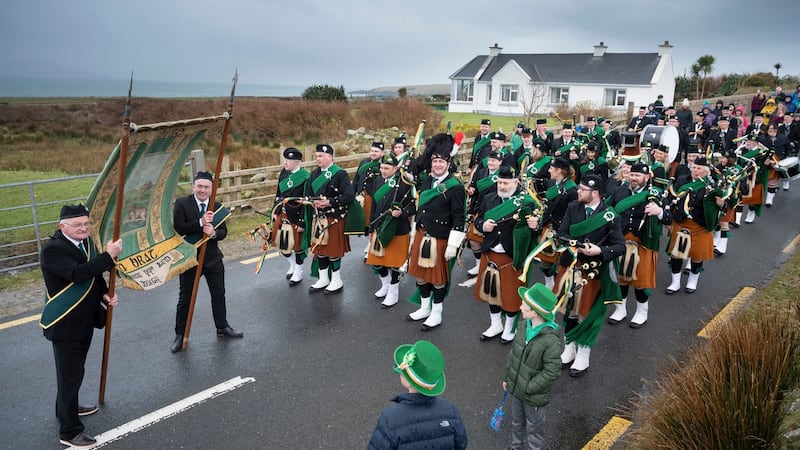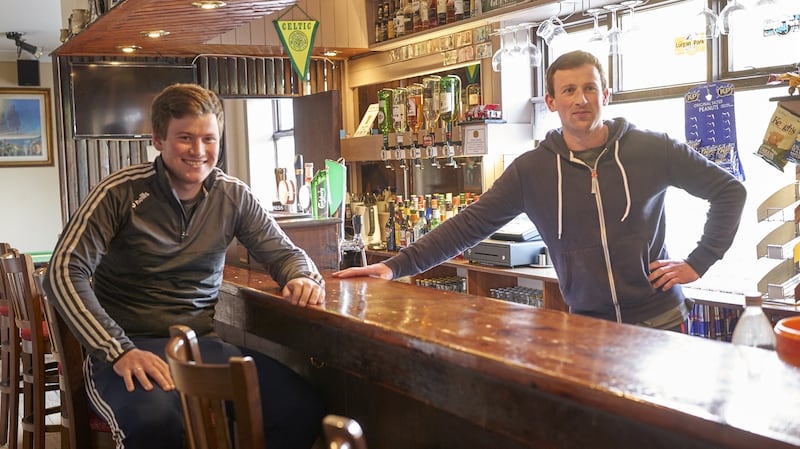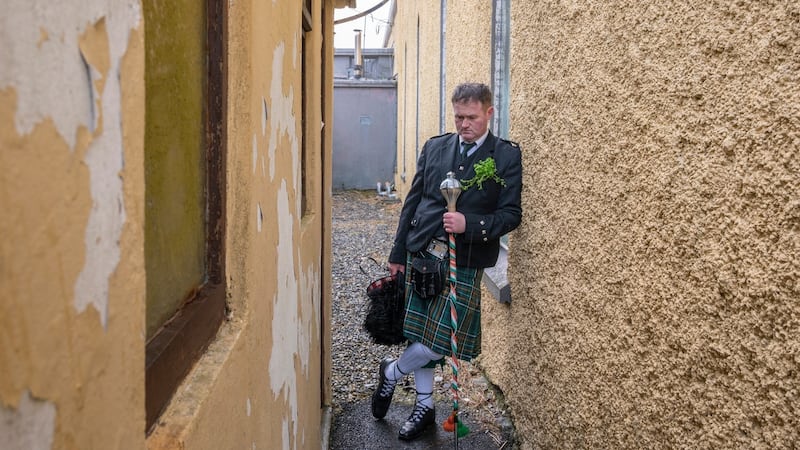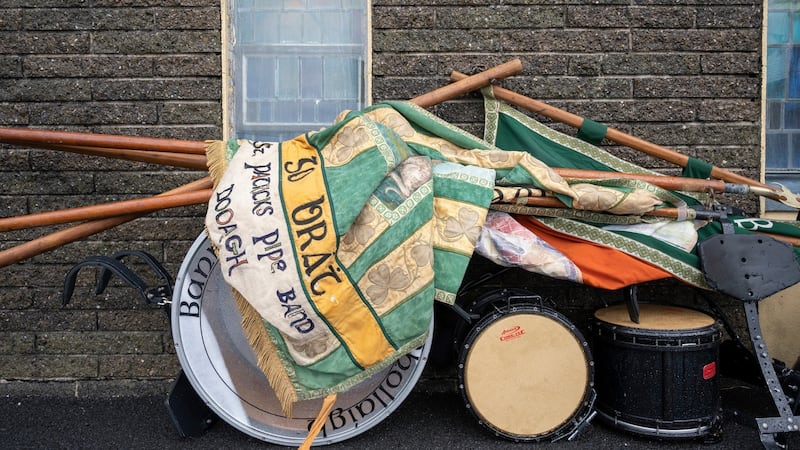St Patrick's morning at 6am and the beating sound of the drumín mór echoes around the village of Dooagh on the western end of Achill Island. It reverberates much further afield too.
On the way into Dooagh, a banner over the road proclaims: ‘Dooagh Pipe Band Welcomes You Home’.
The wording reflects two realities – that Achill Islanders have scattered to the four corners of the globe, but that scores annually come home for occasions like St Patrick’s Day.


So on Thursday, and again on Friday, natives of Dooagh,Pollagh, Keel, Dookinella and Tonragee watched parades through Dooagh, Keel and onto Dookinella that are older than the State.
'No matter where you are in the world on Paddy's Day, your mind is at home. If you can't be home, you're picturing the band rehearsing, the day itself'
Dooagh piper Declan Weir (37) lives in San Francisco and works as an engineering manager for Stripe in Silicon Valley, but there is nowhere he would rather be on March 17th than to be woken in his native Dooagh.
“No matter where you are in the world on Paddy’s Day, your mind is at home. If you can’t be home, you’re picturing the band rehearsing, the day itself. The pride in the band is huge,” he told The Irish Times.
“You dedicate so much of your childhood to getting into the band and learning the 50 or so tunes. It took two years to learn and master, and the sense of anticipation ahead of St Patrick’s Day is unbelievable. From January on, nothing else is on your mind,” he added.
The St Patrick's Day reunions highlight the seasonality of Achill life, one defined by emigration: "Weekends like this are very busy in Achill simply because more people are at home," says Paddy Lavelle, who runs Mickey's Bar with his brother, Brian, in Dooega on the south side of the island.

But very few can work on Achill, a reality borne out starkly by local national school figures. In 1994 , when Declan Weir and Brian Lavelle were both in national school, Achill's ten national schools had 467 pupils.
Today, the figures are a fraction of former times. Just 190 now go to the surviving seven schools. It is a trend replicated in many rural areas in Mayo and, indeed, elsewhere along the western seaboard.
Reality check
The withdrawal from the Mayo club football championship of Lacken Sarsfields last summer starkly highlighted the challenges. The club has a storied past, but it is losing the numbers game now. The parish's sole national school has just 30 pupils. In 1994 the parish had three schools, with 101 pupils entering their doors every school day.
"We just haven't enough players. It's as simple as that. We have lads all around the world working and there's only a handful at home here. There's nothing to keep them here. There's no jobs, there's nothing," says Lacken GAA chairman Paddy Connor.
Lacken is the home of young Irish rugby star Caelan Doris, who Connor says was an ‘exceptionally talented’ Gaelic footballer but he was always going to be lost to rugby.
They could cope with losing him if he were the only one to go, but he is part of a deluge.
Situated an hour north of Achill, Kiltane were relegated from the Mayo senior football championship in 2021. Their school numbers are healthier than Lacken, with 103 in three schools, but that is just a third of the number a generation ago, when there were 336 children in schools in 1994.
They are glancing nervously at what is happening in Lacken.
'If we lose our GAA clubs in rural areas, we lose a social inclusion that's vital to those communities'
“It just makes you think that if the trend continues, are we gone in 30 years?” wonders current Kiltane GAA manager and former club chairman Ciarán O’Hara. “Were Lacken seeing a trend like this 30 years ago? Population decline is the single greatest issue facing rural GAA clubs,” adds O’Hara, who has researched the topic considerably. “If we lose our GAA clubs in rural areas, we lose a social inclusion that’s vital to those communities.”
The parish rule in the GAA, whereby players can only play for their local club, means the health of the GAA club is intrinsically linked to local demographics. Other rural, northwest Mayo clubs such as Ballycastle, west of Lacken, and Ballycroy, south of Kiltane are facing similar challenges.
It is no surprise that Kiltane and Ballycroy have amalgamated at underage level, as Erris St Pat's, while Ballycastle and Lacken are part of the four club amalgamation of Naomh Padraig, along with Killala and Kilfian.

Ballycastle have seen their figures dwindle from 199 to 64, while in Ballycroy they only have 38 national school children, compared to 112 in 1994. The story is echoed across the border in Connemara. Carna Cashel GAA Club had 330 pupils in the club's area in 1990; now it is 136.
Thriving
However, there are parts of Mayo that are thriving.
The population of schools in Castlebar and Westport has grown slightly, while the growth is more pronounced in towns in the south of the county such as Ballinrobe and Claremorris.
Claremorris has seen national school numbers climb by 14 per cent in that time, from 636 to 724.
In Ballinrobe there is a staggering 37 percent increase, from 388 in 1994 to 532 now.
Often, people in Mayo compare and contrast their lot as a county with the eastern seaboard, but the reality that is there is also a two-tier society within the county.
Economist John Bradley, a former research professor with the ESRI, knows the dynamics of the county very well. Based between Dublin and his father's family home in Murrisk, at the foot of Croagh Patrick, he undertook an exhaustive study of the economy of Co Mayo in 2019.

One of his findings was a north-south divide in the county. Areas in the south benefited from proximity to the county town of Castlebar and, crucially, Galway city and even Dublin.
Dr Bradley says Sligo does not have anything like the capacity to serve as an attractor for north Mayo in the way Galway does for south Mayo.
Areas such as Achill and Kiltane are further hindered by the reality that they are the guts of an hour west and north-west from Castlebar.
‘North-south divide’
"The thing that leaps out at you when you look at the population growth of towns in Mayo of 1,000 people or more is that there's a north-south divide. Between the Census of 1991 and 2016, the population of Crossmolina fell by 13 percent. In the same period the population of Claremorris rose by 93 percent.
“These are consequences of national development policies that are inexorably playing out in counties and these are the results. This has been playing out for decades,” says Dr Bradley.
But there are some chinks of light. Brian Lavelle in Dooega on Achill Island is himself an example of how the trend can be bucked.
The draw to home to play Gaelic football with Achill and help run the family pub meant he hopped in the car every weekend for an exhausting eight-hour round trip
He qualified from IT Sligo as a quantity surveyor and started working in Dublin in telecommunications in 2016, based in the Obelisk office in Blanchardstown.
He lived in Dublin during the week but the draw to home to play Gaelic football with Achill and help run the family pub meant he hopped in the car every weekend for an exhausting eight-hour round trip.
Then Covid arrived and suddenly everything changed.
Lavelle was able to work from home in Dooega and has continued to do so since. Plenty more have too. Right now he is hopeful it will be a permanent situation and it has changed his reality considerably.
“It has made a huge difference. It cuts out eight hours in the car every weekend straight away. The cost of living is way down. I’m lucky to be living at home but even if I was renting, while rents here have increased since Covid arrived, it would still be considerably cheaper than renting in Dublin,” he says.










